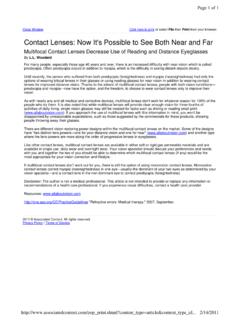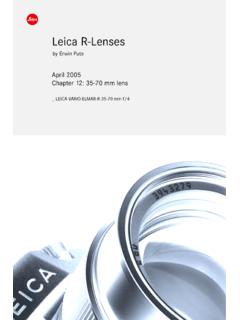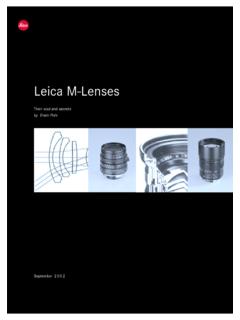Transcription of Occupational Lenses— How they work - Basic Optical
1 Occupational LensesOccupational lenses How they work How they work The term office/ Occupational lens is widely used to refer to varifocal lenses specifically designed for use in limited spaces. Office actually refers to the Shamir-branded product, but the name has become a general term to refer to a certain class of lenses . It provides drastically wider corridors than traditional varifocal lenses - guaranteed crystal clear vision for the printed page, computer screen area and beyond, but not further than 4 meters, depending on the script. The huge gains in terms of corridor width unfortunately is at the expense of : a reduced top part of the lens, limited field of distance vision, that is relative to progressive lenses ; also, the design does not allow for a choice of Rx in the top part of the lens, from the fitting cross upwards where the distance correction in a progressive lens would normally be found, the Occupational lens would more often than not only offer intermediate distance vision.
2 That is in essence the difference between these types of varifocals and traditional, multi-purpose varifocals. The latter are termed progressives, because the power gradually progresses to a point (at the lower end of the lens) where the near vision power is located. In contrast to this, the office lens is manufactured to correct near and intermediate vision, and the lens power from the fitting cross upwards is a factor of : the add power the choice of dynamic power, the amount of power reduction from the add to the fitting cross. The example below illustrates the effect of the choice of dynamic power on the lens power in the top part of the lens. For purposes of this example, the patient distance Rx is + and the add power + : The office/ Occupational lens is therefore also called a degressive lens.
3 The choice of dynamic powers might differ between different brands. Conclusion: Any patient working in an small environment who would benefit from these lenses : a wide range of professionals: doctors, chefs, musicians, artists, accountants, car mechanics , people with orthopaedic problems and other workers requiring concentrated vision for up to 4 meters (13 feet). Ideally, all presbyopes working in small environments should have these lenses in addition to progressives. FOR ADDITIONAL INFORMATION CALL TEL 021-948 4256 OR E-MAIL Dynamic power Resultant intermediate correction + + + plano Ordering requirements Min fitting height 16mm, depending on brand. Ideally 13mm should be allowed between fitting cross and top of lens.
4 Monocular patient PD s. Provide distance Rx & add power required. Dynamic power must be indicated. The higher the dynamic power, the more gradual the power change, the narrower zones of vision.







